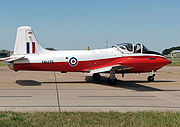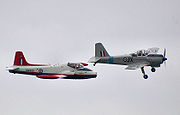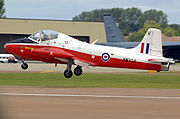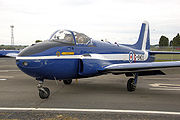
BAC Jet Provost
Encyclopedia
The BAC
Jet Provost (originally built by Hunting Percival) was a British
jet
-powered trainer aircraft used by the Royal Air Force
(RAF) from 1955 to 1993. The Jet Provost was also successfully exported, serving in many air forces worldwide.
basic trainer. On 26 June 1954, the prototype XD674 made its first flight from the factory at Luton Airport, flown by Dick Wheldon. The Air Ministry
ordered ten of the Jet Provost T1.
In June 1957, an order was placed for the first 40 of the developed Jet Provost T3, featuring a more powerful Armstrong Siddeley Viper jet engine, ejector seats, a redesign of the airframe, and a shortened and strengthened version of the retractable tricycle undercarriage
. Percival built one example used purely for structural tests throughout the development stages, giving the designers valuable research into what could be achieved with the basic design. In total, 201 T3s were delivered between 1958 and 1962.
The T4 followed in 1961, fitted with a new Viper engine, and this was followed by the pressurised
T5 in 1967.
The T51 was an armed export version, sold to Ceylon (Sri Lanka)
, Kuwait
and Sudan
. It was armed with two 7.7-mm (0.303-inch) machine gun
s. The T52 was another export version sold to Iraq
, South Yemen, Sudan and Venezuela
, with the same armament as the T51. The T55 was the final armed export version which was sold to Sudan.
A more heavily armed variant of the airframe was developed as the BAC Strikemaster.

 The Jet Provost proved to be a capable trainer. After successful acceptance trials of the T1 during late 1955 at No. 2 Flying Training School at RAF Hullavington
The Jet Provost proved to be a capable trainer. After successful acceptance trials of the T1 during late 1955 at No. 2 Flying Training School at RAF Hullavington
, the RAF formally accepted the type in 1957. The first production version was the T3, powered by the Viper 102, and this entered service with No. 2 FTS, now relocated to RAF Syerston
, during June 1959, when deliveries commenced from the Hunting Aircraft factory at Luton airport.
The later T4 was fitted with the more powerful Viper A.S.V. 11 of 2,500 lbs static thrust
and first flew on 15 July 1960. It quickly entered service with several Flying Training Schools including No. 1, No. 2, No. 3 and No. 6.
The T5 variant was further developed and fitted with the Viper 201 and cockpit pressurisation. These developments encouraged the RAF to utilise the Jet Provost in a number of different roles besides basic training. With a top speed of 440 mph, excellent maneuverability, mechanical reliability and low operating costs, the Jet Provost was utilized as an aerobatic
aircraft, air warfare and tactical weapons training as well as advanced training. The first T5 made its maiden flight on 28 February 1967 and deliveries from BACs Warton
factory commenced on 3 September 1969. Operators of the T 5 included the RAFs Central Flying School
and No. 1, No. 3 and No. 6 Flying Training Schools.
Besides service with the RAF, the Jet Provost found success in export markets. Jet Provosts were withdrawn from RAF service in the early 1990s and replaced by Short Tucano
s. The Jet Provost remains popular among enthusiasts and being an inexpensive jet, many are now in private hands. Some are flown at airshows.


 Iraq
Iraq
 South Yemen
South Yemen
 Venezuela
Venezuela
British Aircraft Corporation
The British Aircraft Corporation was a British aircraft manufacturer formed from the government-pressured merger of English Electric Aviation Ltd., Vickers-Armstrongs , the Bristol Aeroplane Company and Hunting Aircraft in 1960. Bristol, English Electric and Vickers became "parents" of BAC with...
Jet Provost (originally built by Hunting Percival) was a British
United Kingdom
The United Kingdom of Great Britain and Northern IrelandIn the United Kingdom and Dependencies, other languages have been officially recognised as legitimate autochthonous languages under the European Charter for Regional or Minority Languages...
jet
Jet engine
A jet engine is a reaction engine that discharges a fast moving jet to generate thrust by jet propulsion and in accordance with Newton's laws of motion. This broad definition of jet engines includes turbojets, turbofans, rockets, ramjets, pulse jets...
-powered trainer aircraft used by the Royal Air Force
Royal Air Force
The Royal Air Force is the aerial warfare service branch of the British Armed Forces. Formed on 1 April 1918, it is the oldest independent air force in the world...
(RAF) from 1955 to 1993. The Jet Provost was also successfully exported, serving in many air forces worldwide.
Design and development
In the 1950s the RAF issued a requirement for a new dedicated jet training aircraft. Hunting Percival developed the Jet Provost from the piston-engined Percival ProvostPercival Provost
|-See also:-References:NotesBibliography* Angelucci, Enzo. World Encyclopedia of Military Aircraft. London: Jane's Publishing, 1981. ISBN 0-7106-0148-4....
basic trainer. On 26 June 1954, the prototype XD674 made its first flight from the factory at Luton Airport, flown by Dick Wheldon. The Air Ministry
Air Ministry
The Air Ministry was a department of the British Government with the responsibility of managing the affairs of the Royal Air Force, that existed from 1918 to 1964...
ordered ten of the Jet Provost T1.
In June 1957, an order was placed for the first 40 of the developed Jet Provost T3, featuring a more powerful Armstrong Siddeley Viper jet engine, ejector seats, a redesign of the airframe, and a shortened and strengthened version of the retractable tricycle undercarriage
Undercarriage
The undercarriage or landing gear in aviation, is the structure that supports an aircraft on the ground and allows it to taxi, takeoff and land...
. Percival built one example used purely for structural tests throughout the development stages, giving the designers valuable research into what could be achieved with the basic design. In total, 201 T3s were delivered between 1958 and 1962.
The T4 followed in 1961, fitted with a new Viper engine, and this was followed by the pressurised
Cabin pressurization
Cabin pressurization is the pumping of compressed air into an aircraft cabin to maintain a safe and comfortable environment for crew and passengers when flying at altitude.-Need for cabin pressurization:...
T5 in 1967.
The T51 was an armed export version, sold to Ceylon (Sri Lanka)
Sri Lanka
Sri Lanka, officially the Democratic Socialist Republic of Sri Lanka is a country off the southern coast of the Indian subcontinent. Known until 1972 as Ceylon , Sri Lanka is an island surrounded by the Indian Ocean, the Gulf of Mannar and the Palk Strait, and lies in the vicinity of India and the...
, Kuwait
Kuwait
The State of Kuwait is a sovereign Arab state situated in the north-east of the Arabian Peninsula in Western Asia. It is bordered by Saudi Arabia to the south at Khafji, and Iraq to the north at Basra. It lies on the north-western shore of the Persian Gulf. The name Kuwait is derived from the...
and Sudan
Sudan
Sudan , officially the Republic of the Sudan , is a country in North Africa, sometimes considered part of the Middle East politically. It is bordered by Egypt to the north, the Red Sea to the northeast, Eritrea and Ethiopia to the east, South Sudan to the south, the Central African Republic to the...
. It was armed with two 7.7-mm (0.303-inch) machine gun
Machine gun
A machine gun is a fully automatic mounted or portable firearm, usually designed to fire rounds in quick succession from an ammunition belt or large-capacity magazine, typically at a rate of several hundred rounds per minute....
s. The T52 was another export version sold to Iraq
Iraq
Iraq ; officially the Republic of Iraq is a country in Western Asia spanning most of the northwestern end of the Zagros mountain range, the eastern part of the Syrian Desert and the northern part of the Arabian Desert....
, South Yemen, Sudan and Venezuela
Venezuela
Venezuela , officially called the Bolivarian Republic of Venezuela , is a tropical country on the northern coast of South America. It borders Colombia to the west, Guyana to the east, and Brazil to the south...
, with the same armament as the T51. The T55 was the final armed export version which was sold to Sudan.
A more heavily armed variant of the airframe was developed as the BAC Strikemaster.
Operational service


RAF Hullavington
RAF Hullavington was a Royal Air Force station in Hullavington, near Chippenham, Wiltshire.RAF Hullavington has switched regiments. At the current time it is RLC-Royal Logistic Corps.-History:Opened on 9 July 1937 as a Flying Training School....
, the RAF formally accepted the type in 1957. The first production version was the T3, powered by the Viper 102, and this entered service with No. 2 FTS, now relocated to RAF Syerston
RAF Syerston
RAF Syerston is a Royal Air Force station in the parish of Flintham, near Newark, Nottinghamshire. It was used as a bomber base during World War II.-Bomber Command:...
, during June 1959, when deliveries commenced from the Hunting Aircraft factory at Luton airport.
The later T4 was fitted with the more powerful Viper A.S.V. 11 of 2,500 lbs static thrust
Thrust
Thrust is a reaction force described quantitatively by Newton's second and third laws. When a system expels or accelerates mass in one direction the accelerated mass will cause a force of equal magnitude but opposite direction on that system....
and first flew on 15 July 1960. It quickly entered service with several Flying Training Schools including No. 1, No. 2, No. 3 and No. 6.
The T5 variant was further developed and fitted with the Viper 201 and cockpit pressurisation. These developments encouraged the RAF to utilise the Jet Provost in a number of different roles besides basic training. With a top speed of 440 mph, excellent maneuverability, mechanical reliability and low operating costs, the Jet Provost was utilized as an aerobatic
Aerobatics
Aerobatics is the practice of flying maneuvers involving aircraft attitudes that are not used in normal flight. Aerobatics are performed in airplanes and gliders for training, recreation, entertainment and sport...
aircraft, air warfare and tactical weapons training as well as advanced training. The first T5 made its maiden flight on 28 February 1967 and deliveries from BACs Warton
Warton, Fylde
Warton is a village on the Fylde in Lancashire, England.The village is about six miles from Preston and eight miles from Blackpool. It is located on the banks of the River Ribble, close to its entry into the Irish Sea. It is best known for its airfield, BAE Warton and its associated aircraft works...
factory commenced on 3 September 1969. Operators of the T 5 included the RAFs Central Flying School
Central Flying School
The Central Flying School is the Royal Air Force's primary institution for the training of military flying instructors. Established in 1912 it is the longest existing flying training school.-History:...
and No. 1, No. 3 and No. 6 Flying Training Schools.
Besides service with the RAF, the Jet Provost found success in export markets. Jet Provosts were withdrawn from RAF service in the early 1990s and replaced by Short Tucano
Short Tucano
|-See also:-External links:*...
s. The Jet Provost remains popular among enthusiasts and being an inexpensive jet, many are now in private hands. Some are flown at airshows.
Variants
| Model | Number built | Manufacturer | Comments |
|---|---|---|---|
| Jet Provost T1 | 12 | Hunting Percival | Initial production batch for the RAF. |
| Jet Provost T2 | 4 | Hunting Percival | Development aircraft only. |
| Jet Provost T3 | 201 | Hunting Aircraft | Main production batch for the RAF. |
| Jet Provost T3A | (70) | Hunting | Modified T3 with improved avionics for the RAF. |
| Jet Provost T4 | 198 | BAC | Variant with more powerful engine for the RAF. |
| Jet Provost T5 | 110 | BAC | Pressurised version for the RAF. |
| Jet Provost T5A | (94) | BAC | Converted T5 with improved avionics. |
| Jet Provost T5B | BAC | Unofficial designation, basically a T5 with some conversions and used for navigator training. | |
| Jet Provost T51 | 22 | Hunting Aircraft | Export version of the T3 (12 built for Ceylon, four built for Sudan, and six built for Kuwait). |
| Jet Provost T52 | 43 | BAC | Export version of the T4 (20 built for Iraq, 15 built for Venezuela, eight built for Sudan). |
| Jet Provost T55 | 5 | BAC | Export version of the T5, built for Sudan. |
| BAC Strikemaster | 146 | BAC | Ground attack version of the T5. |


Operators
- Royal Australian Air ForceRoyal Australian Air ForceThe Royal Australian Air Force is the air force branch of the Australian Defence Force. The RAAF was formed in March 1921. It continues the traditions of the Australian Flying Corps , which was formed on 22 October 1912. The RAAF has taken part in many of the 20th century's major conflicts...
- Only one aircraft was ever used by the RAAF. A single Jet Provost T.Mk 2 was in service with the RAAF for six months in 1959, it was used for tests and evaluation with No. 1 Basic Flying Training School RAAF.
- Royal Ceylon Air Force received 12 Jet Provost T51 aircraft.
 Iraq
Iraq
- Iraqi Air ForceIraqi Air ForceThe Iraqi Air Force or IQAF is the military branch in Iraq responsible for the policing of international borders, surveillance of national assets and aerial operations...
received 20 Jet Provost T52 aircraft, 15 of which survived the 1991 Gulf War.
- Kuwait Air ForceKuwait Air ForceThe Kuwait Air Force is the air arm of the State of Kuwait. The Air Force headquarters is located at Al Mubarak Air Base, with the remaining forces stationed at Air Defence Brigade, Ali Al Salem Air Base and Ahmed Al Jaber Air Base...
received six Jet Provost T51 aircraft.
- Portuguese Air ForcePortuguese Air ForceThe Portuguese Air Force is the air force of Portugal. Formed on July 1, 1952, with the Aeronáutica Militar and Aviação Naval united in a single independent Air Force, it is one of the three branches of the Portuguese Armed Forces and its origins dates back to 1912, when the military aviation...
received one Jet Provost T.Mk 2B in 1959.
- Republic of Singapore Air ForceRepublic of Singapore Air ForceThe Republic of Singapore Air Force is the air arm of the Singapore Armed Forces. It was first established in 1968 as the Singapore Air Defence Command...
- 3 x T.52s (ex-South Yemen Air Force airframe) operated from the 1975 until 1980.
 South Yemen
South Yemen
- South Yemen Air Force
- Sudan Air Force received four Jet Provost T51, eight T52 and five T55 aircraft.
- Royal Air ForceRoyal Air ForceThe Royal Air Force is the aerial warfare service branch of the British Armed Forces. Formed on 1 April 1918, it is the oldest independent air force in the world...
 Venezuela
Venezuela
- Venezuelan Air Force received 15 Jet Provost T52 aircraft.

